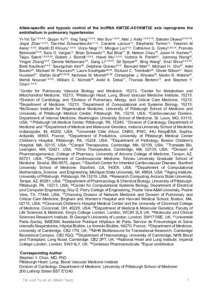Tai, Y-Y;
Yu, Q;
Tang, Y;
Sun, W;
Kelly, NJ;
Okawa, S;
Zhao, J;
Schwantes-An, T-H;
Lacoux, C;
Torrino, S;
et al.
Tai, Y-Y; Yu, Q; Tang, Y; Sun, W; Kelly, NJ; Okawa, S; Zhao, J; Schwantes-An, T-H; Lacoux, C; Torrino, S; Al Aaraj, Y; El Khoury, W; Negi, V; Liu, M; Corey, CG; Belmonte, F; Vargas, SO; Schwartz, B; Bhat, B; Chau, BN; Karnes, JH; Satoh, T; Barndt, RJ; Wu, H; Parikh, VN; Wang, J; Zhang, Y; McNamara, D; Li, G; Speyer, G; Wang, B; Shiva, S; Kaufman, B; Kim, S; Gomez, D; Mari, B; Cho, MH; Boueiz, A; Pauciulo, MW; Southgate, L; Trembath, RC; Sitbon, O; Humbert, M; Graf, S; Morrell, NW; Rhodes, CJ; Wilkins, MR; Nouraie, M; Nichols, WC; Desai, AA; Bertero, T; Chan, SY
(2024)
Allele-specific control of rodent and human lncRNA KMT2E-AS1 promotes hypoxic endothelial pathology in pulmonary hypertension.
Science Translational Medicine, 16 (729).
ISSN 1946-6234
https://doi.org/10.1126/scitranslmed.add2029
SGUL Authors: Southgate, Laura
![[img]](https://openaccess.sgul.ac.uk/116001/1.hassmallThumbnailVersion/Tai%20and%20Yu%20et%20al%202023_accepted.pdf)  Preview |
|
PDF
Accepted Version
Available under License ["licenses_description_publisher" not defined].
Download (18MB)
| Preview
|
Abstract
Hypoxic reprogramming of vasculature relies on genetic, epigenetic, and metabolic circuitry, but the control points are unknown. In pulmonary arterial hypertension (PAH), a disease driven by hypoxia inducible factor (HIF)–dependent vascular dysfunction, HIF-2α promoted expression of neighboring genes, long noncoding RNA (lncRNA) histone lysine N-methyltransferase 2E-antisense 1 (KMT2E-AS1) and histone lysine N-methyltransferase 2E (KMT2E). KMT2E-AS1 stabilized KMT2E protein to increase epigenetic histone 3 lysine 4 trimethylation (H3K4me3), driving HIF-2α–dependent metabolic and pathogenic endothelial activity. This lncRNA axis also increased HIF-2α expression across epigenetic, transcriptional, and posttranscriptional contexts, thus promoting a positive feedback loop to further augment HIF-2α activity. We identified a genetic association between rs73184087, a single-nucleotide variant (SNV) within a KMT2E intron, and disease risk in PAH discovery and replication patient cohorts and in a global meta-analysis. This SNV displayed allele (G)–specific association with HIF-2α, engaged in long-range chromatin interactions, and induced the lncRNA-KMT2E tandem in hypoxic (G/G) cells. In vivo, KMT2E-AS1 deficiency protected against PAH in mice, as did pharmacologic inhibition of histone methylation in rats. Conversely, forced lncRNA expression promoted more severe PH. Thus, the KMT2E-AS1/KMT2E pair orchestrates across convergent multi-ome landscapes to mediate HIF-2α pathobiology and represents a key clinical target in pulmonary hypertension.
Statistics
Item downloaded times since 15 Jan 2024.
Actions (login required)
 |
Edit Item |


